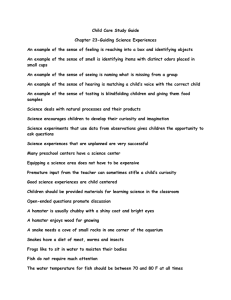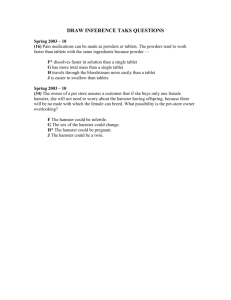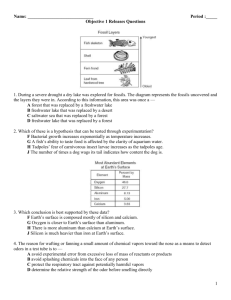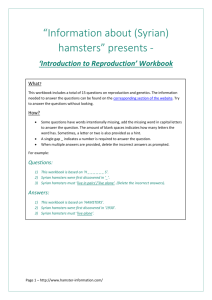Rodents Continued: Hamster and Gerbil Managment I
advertisement
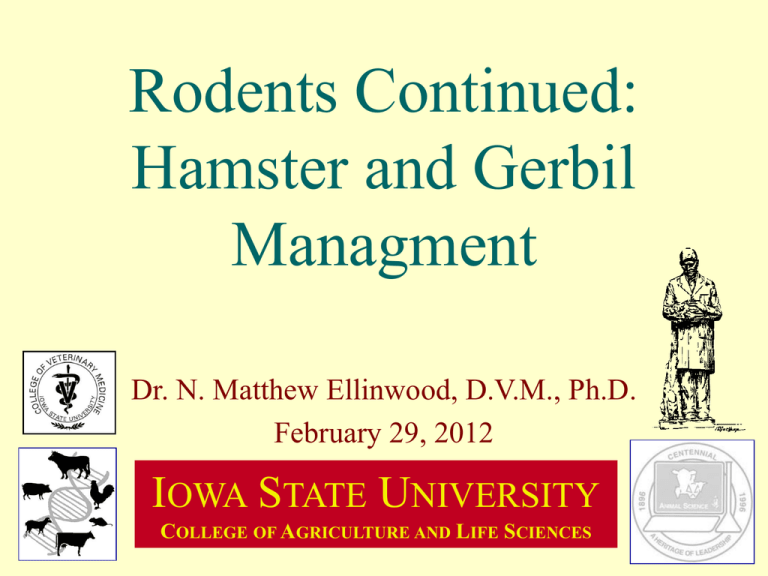
Rodents Continued: Hamster and Gerbil Managment Dr. N. Matthew Ellinwood, D.V.M., Ph.D. February 29, 2012 IOWA STATE UNIVERSITY COLLEGE OF AGRICULTURE AND LIFE SCIENCES HAMSTER & GERBIL MANAGEMENT Hamsters • • • • • Mesocricetus auratus – golden Cricetulus griseus – Chinese Cricetus cricetus – European Cricetulus migratorius – Armenian Phodopus sungorus – Russian or Siberian, or Dzungarian Taxonomy • Kingdom: Animalia Phylum: Chordata Subphylum: Vertebrata Class: Mammalia Order: Rodentia Suborder: Myomorpha Superfamily: Muroidea Family: Cricetidae Subfamily: Cricetinae • Cricetidae (True hamsters, voles, lemmings, and New World rats and mice; 600 species and second largest family) • Cricetinae (hamsters; subfamily of Cricetidae) – 25 species in 6-7 genera – Cricetulus • Cricetulus griseus (Chinese hamster) • Cricetulus migratorius (Armenian hamster) – Cricetus • Cricetus cricetus (black-bellied or European hamster) – Mesocricetus • Mesocricetus auratus (golden hamster) – Phodopus • Phodopus sungorus (striped hairy-footed, Russian, Siberian, or Dzungarian hamster) Habitat and Natural History • • • • • First described in 1839 (Golden Hamster) Hamster (German for “hoarder”) First domesticated in 1930 (Syrian Hamster) Expandible cheek pouches Polyestrous – 4 day cycle Golden Hamster • Mesocricetus auratus • Syria (now considered a vulnerable species) • Circadian – Active after dusk, late night, and dawn; wild vs lab • Adult size and life span – 5-7 inches, 2-3 years • Expandable cheek pouches (common to hamsters) • Anecdotal accounts – 25 kg in burrows – Arabic dialect “Mr. Saddlebags” • 16 day pregnancy (shortest of all placentals) • 8-10 young – Can be stressed to abandonment or cannibalism • “Foal” heat • Territorial (housing issues) • Separate by gender at weaning (3 wks) – Sexually mature by 4-5 weeks • Natural habitat – Dry desert climate • Mitochondrial evidence supports only one maternal line in domestic golden hamsters – Sought as an alternative to Chinese hamster – Domesticated in Mandatory Palestine by Israel Aharoni, 1930, Hebrew University, Jerusalem; Mother and litter • Invasive species in Israel – 1931 to Britain’s Wellcome Bureau of Scientific Research Lab Animal • 4th most used lab species of rodent • Circadian research • Consistent behaviors of marking and grooming make good ethology models • All lab golden hamsters – Descended from 3 animals – Highly inbred – Inbred lines • Cardiomyopathy – Dialated cardiomyopathy – Cause of sudden death – Strain BIO14.6 • Delta-sarcoglycan mutation Housing and welfare concerns • Large diameter wheels • Bedding that allows nesting materials • Not recommended for children younger than 7 years of age • Require adult supervision • Large enclosures which allow sufficeint room for exercise Wide Variety of Colors and Patterns and Hair Lengths • Short haired • Teddy Bear (Angora) • Self versus Agouti colors • Self colors – Cream (UK 1951) – Black (UK 1991) • Whites – Black eyed white – Dark eared white – Flesh eared white • Agouti colors – Sable (1975) – Wild Type Patterning and Orange • Banding, pie balding, spotting and X linked orange all seen Chinese Hamster • Longer bodied • More mouse/rat like – Grouped as a “rat like hamster”, ie genus Cricetulus – Longer tail – Males have prominent scrotum – Females usually kept in pet trade – Shown dominant white mutation • Wild type coloration of a Chinese hamster Campbell's dwarf hamster • Phodopus campbelli • AKA – Russian dwarf hamster – Djungarian (or Dzungarian) dwarf hamster • Social hamsters Winter White Russian Dwarf Hamster • Phodopus sungorus • Social hamsters • Can hybridize with Cambells Anatomy • Cheek pouches • Flank marking glands • Sexual dimorphism (females larger) Handling • • • • Easily startled Can be inclined to bite Handle by cupping Scuffing if necessary • Housing management – – – – – Houdini’s Solid surface enclosure Stainless steel Polycarbonate plastic Something that cannot be chewed through Bedding • • • • Corn cob Paper Hardwood AVOID – Cedar – Pine • Nesting material (especially females) • Housing/hutches/enclosures Feeding • Granivorous • Food hoarders (hoards are discretely located far from latrines) • Commercial chow – 17-23% Crude Protein – 6-8% Crude Fiber – 4.5% Crude Fat • Blunt noses and feeders • Coprophagous • Vit E deficiency (muscle weekness – White Muscle Disease – Fresh milled within last 6 months Breeding and Housing Mgmt • Sex by anogenital distance – Separte at 3 weeks (weaning) by sex • Solitary in wild • Estrus every 4 days (24 hours) • Female to male cage (short periods – never unattended) • Fighting or lordosis – Mating within 30 min to 4 hours Gestation and Parturition • 16 day gestation (15-18 days) – Longer gestations increase complications • • • • • Clean cage before parturition so as not to disturb young Birth usually at night Non-prococial young (altricial) 1 delivered/10 min Avoid disturbance for 2 weeks (haired and visual) – Cannibalism – First time dams but also experienced dams Diseases • Viral induced lymphoma – Hamster polyoma virus – DNA virus stable in enviornment and easily transmissible – Bacterial disease • Hamster enteritis complex – Proliferative ileitis » Wet tail (Lawsonia intracellularis) – Tyzzer’s Disease » Clostirdium piliforme – Clostridiosis » Cl. perfirngens, and difficile (antibiotics) Diseases • Parasites – No significant risk – Kindey failure • Common age related cause of death • Atrial Thromosis – Associated with sudden death (older females) • Cancer (rare) – Zoonoses • Lymphocytic choriomeningitis (LCM) • Salmonellosis – Allergies rare Gerbils • Mongolian gerbil – Meriones unguiculatus Taxonomy • Kingdom: Animalia Phylum: Chordata Class: Mammalia Order: Rodentia Family: Muridae Subfamily: Gerbillinae Genus: Meriones Subgenus: Pallasiomys Species: M. unguiculatus Gerbillinae • • • • • Subfamily of rodents 14 genera 110 species Old world rodents Often adapted to harsh desert enviorns Domestication • First described in 1867 • Gerbil from Jerboa, a semitic name of a local type of near eastern unrelated desert rodent • 19th Century pet in France • US stock to US in 1954 By Dr Vicotr Schwetker Habitat and Natural History • • • • • Desert of Mongolia and North China Large burrow complex Large family structure Single breeding pair Wide temperature fluctuations • Crepuscular and diurnal Social and Clannish • • • • Best kept in same sex pairs Will fight unknown/new animals Pair up littermates early (before 12 weeks) Pair up breeding pairs early (at or before 12 weeks) • Breeding pairs cannot be reestablished as adults • Fighting can be a problem in even established pairings Housing • Solid floored cage (burrowing) • Maloclusion (chewing substrate – avoid plastic) • Low humidity (30%) – Higher humidity can be a problem • Tolerate fulx in temperatures well • Paper/wood shaving bedding – Sand (sore nose) Feeding • Produce little urine and drink little water – Should be supplied nonetheless • Not coprophagic • Feed commercial rodent chow. • Not a hoarding speices – Store calories as fat • Will self select for high fat grains/seeds – Ex: sunflowers – limit as a treat item only Handling • Do not grasp by tail – Degloving injury – Causes tail to necrose and slough – May require amputation • Base of tail • Scruffing when necessary Common Diseases • • • • • Seizure Black Gerbils most susceptible Sore nose (nasal dermatitis) Degloving High humidity – Rough hair coat • Tyzzer disease – Cl. piliforme – Usually fatal Research • Stroke model • Incomplete circle of Willis Colors and Patterns • Over 30 different patters and colors observed in the Gerbil fancy Golden Agouti (Wild Type) Schimmels Light Red Fox Nutmeg Silver Nutmeg Lilac Dove Fat Tailed Gerbils • Pachyuromys duprasi • North African gerbil
